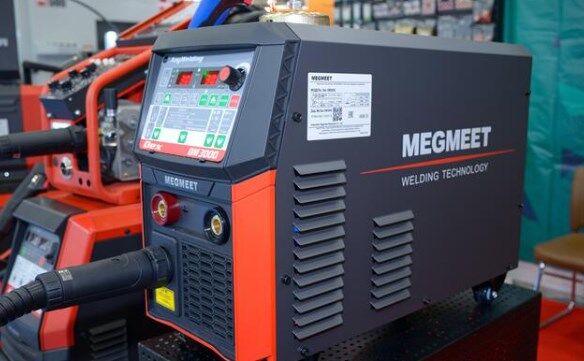Welding lies at the heart of modern manufacturing, from heavy steel structures to precision automotive parts. For industrial users, investing in welding equipment isn’t just about joining metal—it’s about productivity, quality, cost efficiency, and the ability to tackle complex jobs reliably.
Unlike hobby-level machines, industrial welders must withstand demanding workloads, deliver consistent performance, and integrate seamlessly into production environments. This guide examines key factors that professionals should consider when acquiring industrial welding systems, whether for new facilities, production upgrades, or expanding fabrication capabilities.

I. Understanding Your Welding Application:
Industrial welding equipment isn’t one-size-fits-all. Start by defining:
Materials: Mild steel, stainless steel, aluminum, exotic alloys?
Thickness range: Thin sheet or heavy plate?
Welding positions: Flat shop work vs. overhead field welding?
Joint configurations: Fillet welds, butt welds, corner welds, specialized geometries?
Production volume: Short runs or high-volume, multi-shift operations?
Quality standards: Structural codes, pressure vessel standards, aerospace specs?
Integration needs: Robot automation, digital production monitoring?
The answers shape every subsequent equipment decision.
II. Key Factors in Selecting Industrial Welding Machines:
Let’s dive into the core technical considerations for choosing industrial-grade machines.
1. Input Power and Electrical Requirements
Industrial facilities often have access to three-phase power, crucial for running higher-output machines efficiently. Check:
Available voltages (e.g. 380–415V or 480V three-phase)
Total power capacity
Compatibility with other electrical loads
Local regulations on peak demand
Higher output machines may draw substantial current under load, so verify facility infrastructure before finalizing equipment specs.
2. Duty Cycle and Thermal Management
In industrial production, duty cycle isn’t merely a convenience—it determines productivity.
Duty cycle indicates how many minutes a machine can weld in a 10-minute period at a specified amperage without overheating. For instance:
For multi-shift production, choose machines with high-duty cycles to avoid bottlenecks.
3. Process Versatility
Industrial welders often need multi-process capabilities:
GMAW (MIG/MAG): Fast, high-deposition rates, suitable for most structural fabrication.
GTAW (TIG): Precision welding, thin materials, critical weld appearance, high-quality requirements.
SMAW (Stick): Excellent for field welding, maintenance, and thick sections.
FCAW (Flux-Cored): High deposition rates, effective outdoors or for heavy fabrication.
SAW (Submerged Arc): Extremely high deposition for heavy plate welding.
Modern digital welding systems like those from Megmeet can support multiple processes from a single power source, increasing flexibility and reducing equipment footprint.
4. Welding Current Range
Industrial jobs often demand higher welding currents. Typical industrial ranges:
| Machine Class | Typical Amperage Range | Suitable Work |
|---|
| Medium-duty | 30–350 A | Light fabrication, general manufacturing |
| Heavy-duty | 30–500 A | Structural steel, shipbuilding, pressure vessels |
| High-current | Up to 800 A | SAW, thick-section welds, large assemblies |
Consider your thickest material and joint design when choosing maximum amperage. For thick steel sections, single-pass penetration might require currents above 400 A.
5. Arc Stability and Digital Controls
High-end industrial welders now use advanced digital control platforms. Benefits include:
Precise arc characteristics: Lower spatter, smoother beads
Process tuning: Adjustable waveforms, pulse parameters, arc force, hot start
Repeatability: Essential in production where consistent weld quality is mandatory
Integration: Connectivity to factory networks, robot controllers, or IoT systems
Megmeet’s digital welding power sources, for instance, enable parameter storage, real-time monitoring, and adaptive control, crucial for modern manufacturing.
6. Automation Readiness
In many industries, robotic welding is standard practice. When choosing industrial machines:
Check for digital communication protocols (Ethernet/IP, ProfiNet, Modbus, etc.)
Evaluate the ability to store and recall welding schedules for different parts
Confirm integration with robotic welding arms or positioners
Look for remote diagnostics and Industry 4.0 readiness
Automated welding lines can boost productivity but require equipment engineered for precise and repeatable performance.
7. Safety and Environmental Compliance
Industrial machines operate at high outputs, creating risks including:
Arc flash hazards
Fume and gas emissions
Electrical hazards
Heat exposure
Choose machines that:
Meet regional safety standards (e.g. CE, UL, CCC)
Include thermal overload protection
Offer integrated fume extraction connections
Support safer low-heat input processes where possible
In many industries, compliance with occupational health standards is non-negotiable.
III. Notes on Selecting Specific Industrial Processes:
Let’s explore how different industrial processes influence equipment choice.
1. Notes on Selecting an Industrial Stick Welder (SMAW)
Even in modern factories, Stick welding remains vital for:
For industrial Stick welding:
Prefer DC output for smoother arc and reduced spatter
Seek machines with arc force (dig) control for root passes in open-root joints
Opt for high-duty-cycle inverters for continuous welding on thick sections
Industries like shipbuilding or heavy equipment manufacturing rely on Stick welders that deliver robust performance under challenging conditions.
2. Notes on Buying an Industrial MIG/MAG Welder (GMAW)
In industrial environments, MIG/MAG and flux-cored welding dominate due to:
High deposition rates
Low operator fatigue
Automation compatibility
When selecting an industrial MIG/MAG welder:
Look for high-current capability (350 A or more) for thicker materials
Seek pulse MIG functions for spatter reduction and superior weld bead appearance
Consider dual-wire systems for quick wire changes between materials
Evaluate inductance controls for fine-tuning arc characteristics, especially on stainless steel
Confirm compatibility with robotic MIG guns if automation is planned
Top 10 GMAW Welding Machine Brands in the World (in 2023)
3. Notes on Selecting an Industrial TIG Welder (GTAW)
TIG is critical in industries demanding exceptional precision:
Industrial TIG welders should offer:
AC/DC capability for welding aluminum and magnesium
High-frequency arc start to avoid tungsten contamination
Pulse welding features for heat control on thin materials
Remote current controls (foot pedals, torch sliders) for precise modulation
Digital TIG inverters can store parameters for various joints, ensuring repeatability across production shifts.
Best TIG Welders: Buyer's Guide For TIG AC/DC Welding Machines in 2023
4. Notes on Selecting an Industrial Flux-Cored Arc Welding (FCAW)
FCAW is akin to MIG welding but utilizes a tubular wire filled with flux. This flux shields the weld, eliminating the need for an external shielding gas. It's suitable for outdoor use and works well on thick materials.
IV. What’s the Best Welder for You?
Based on the factors above, here are some general recommendations for choosing the best welder for you:
If you want to weld mostly carbon steel or mild steel in various thicknesses and positions, and you have access to a 220-volt power supply, then a stick welder may be the best option for you. It is simple, inexpensive, and versatile.
If you want to weld mostly thin metals such as aluminum or stainless steel with high quality and precision, and you have access to either AC or DC power supply, then a TIG welder (such as Megmeet MetaTIG 315/400/500 ACDC/DC series welders) may be the best option for you. It is complex and expensive, but very capable.
If you want to weld various metals such as steel, aluminum, or stainless steel in different thicknesses and positions with ease and speed, and you have access to either AC or DC power supply, then a MIG welder (such as Megmeet Ehave-2 CM series welders, Artsen CM500C series welders, Artsen II P(C)M series welders, Artsen Plus D/P/Q series welders and Dex....) may be the best option for you. It is easy, versatile, and efficient.
V. The Future: Digitalization and Welding Data
Beyond simply producing arcs, modern industrial welding systems are data-driven production tools. Key developments include:
Real-time weld monitoring
Traceability of weld parameters
Integration with MES or ERP systems
Predictive maintenance diagnostics
Cloud connectivity for remote support
Investing in digital-ready welding equipment can deliver measurable improvements in quality assurance, productivity, and operational insight.
Conclusion
Choosing industrial welding equipment is a strategic investment. The right machine ensures productivity, meets quality standards, and positions your operation for future growth. Modern digital systems, like those offered by Megmeet, bring flexibility, precision, and connectivity to demanding industrial environments.
Whether building ships, fabricating heavy machinery, or producing precision automotive components, professional welders deserve equipment built for the realities of industrial manufacturing.
If you’re planning your next investment in industrial welding technology, consult experienced application engineers. A clear understanding of your materials, processes, and production goals is the key to selecting a machine that will drive efficiency and deliver outstanding weld quality shift after shift.
Related articles:
1. Choosing the Right Welding Technique: Suggestions for Different Applications
2. What are the 4 Basic Welding Positions and How to Choose the Right One?
3. Choosing the Right Shielding Gases for Arc Welding
4. How to Choose the Best Automated Welding System for your Application?
5. MIG/MAG, MMA, TIG Welding: Choosing the Right Technique




